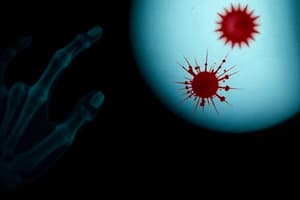Podcast
Questions and Answers
What is the first step in the forensic examination of adhesive samples?
What is the first step in the forensic examination of adhesive samples?
- Visual evaluation of the tape samples
- Documentation of the original condition
- Comparison of physical characteristics
- Critical review of the chain of custody (correct)
What does a physical end match examination focus on?
What does a physical end match examination focus on?
- Evaluating the layer structure of the tape
- Comparing color and size of the tape
- Assessing the type of adhesive used
- Matching edges and surface irregularities (correct)
Which statement best describes the role of a stereomicroscope in forensic tape analysis?
Which statement best describes the role of a stereomicroscope in forensic tape analysis?
- To analyze the adhesive properties of the tape
- To provide a microscopic view for evaluation (correct)
- To document the chain of custody
- To facilitate the physical fit examination
What should be included in documentation during a physical fit examination?
What should be included in documentation during a physical fit examination?
For the characterization of tape samples, which of the following is NOT a physical characteristic evaluated?
For the characterization of tape samples, which of the following is NOT a physical characteristic evaluated?
Which two instrumental techniques are required for analyzing the tape's components?
Which two instrumental techniques are required for analyzing the tape's components?
What type of analysis involves examining the backing and adhesive components of tape?
What type of analysis involves examining the backing and adhesive components of tape?
In forensic tape analysis, what aspect is evaluated during the initial examination?
In forensic tape analysis, what aspect is evaluated during the initial examination?
What is the primary purpose of using Polarized Light Microscopy (PLM) in tape analysis?
What is the primary purpose of using Polarized Light Microscopy (PLM) in tape analysis?
Which of the following materials can be characterized using Polarized Light Microscopy?
Which of the following materials can be characterized using Polarized Light Microscopy?
What information can be gathered about reinforcement fibers using PLM?
What information can be gathered about reinforcement fibers using PLM?
How does Fourier Transform Infrared Spectroscopy (FTIR) contribute to understanding the types of adhesives used in tape?
How does Fourier Transform Infrared Spectroscopy (FTIR) contribute to understanding the types of adhesives used in tape?
What role do plasticizers play in the formulation of tape?
What role do plasticizers play in the formulation of tape?
Which of the following is NOT typically analyzed using FTIR in tape performance assessment?
Which of the following is NOT typically analyzed using FTIR in tape performance assessment?
What specific aspect of the adhesive can PLM reveal regarding its interface with backing materials?
What specific aspect of the adhesive can PLM reveal regarding its interface with backing materials?
Which factor is crucial to understand bonding performance in adhesives as detected by FTIR?
Which factor is crucial to understand bonding performance in adhesives as detected by FTIR?
What type of information can Fourier Transform Infrared Spectroscopy (FTIR) help identify?
What type of information can Fourier Transform Infrared Spectroscopy (FTIR) help identify?
Which technique is better suited for analyzing non-polar molecules?
Which technique is better suited for analyzing non-polar molecules?
What is a limitation of Raman spectroscopy?
What is a limitation of Raman spectroscopy?
What does Pyrolysis Gas Chromatography (PGC) analyze?
What does Pyrolysis Gas Chromatography (PGC) analyze?
Which analysis technique provides both quantitative and qualitative information by decomposing organic compounds?
Which analysis technique provides both quantitative and qualitative information by decomposing organic compounds?
What type of information does Scanning Electron Microscopy coupled with Energy Dispersive X-ray Spectroscopy (SEM-EDS) provide?
What type of information does Scanning Electron Microscopy coupled with Energy Dispersive X-ray Spectroscopy (SEM-EDS) provide?
What does X-ray Fluorescence Spectrometry (XRF) analyze?
What does X-ray Fluorescence Spectrometry (XRF) analyze?
How is the composition comparison generally performed in SEM-EDS?
How is the composition comparison generally performed in SEM-EDS?
Flashcards are hidden until you start studying
Study Notes
Forensic Examination of Adhesives
- Forensic tape analysis begins with evaluating the chain of custody, packaging, and identification markings.
- The initial evaluation of potential cross-contamination between samples is essential.
- The analysis involves a visual evaluation of the tape's condition, weathering characteristics, size, shape, color, and classification.
- This evaluation is done both macroscopically and with a stereomicroscope.
- Physical fit analysis compares edges, surface striae, and other surface irregularities to determine if corresponding samples match.
- Physical fits are documented with detailed notes, images, and videography.
- Macroscopic and stereomicroscopic observations are used to identify the color, texture, thickness, width, and layer structure of the tape components.
- Cross-sections of the tape sample are used to determine its layer structure.
- Polarized Light Microscopy (PLM) is used to characterize inorganic materials and other tape additives.
- PLM can distinguish different materials based on their optical behaviors, which can aid in differentiating components.
- PLM can help observe the size, shape, and distribution of filler materials, providing insights into how they might influence the adhesive's performance.
- PLM is also used to examine the adhesive's penetration and bonding to the backing, crucial for effective performance.
- PLM further analyzes the arrangement, orientation, and interaction of reinforcement fibers in the adhesive.
- Fourier Transform Infrared Spectroscopy (FTIR) is used to identify the type of polymer used in the tape's base material and other materials.
- FTIR helps identify various types of adhesive elastomers, assess their chemical structure, and identify plasticizers and their concentrations.
- FTIR also analyzes stabilizers, fillers, and colorants in adhesives to understand their effects on the tape's durability.
- Raman spectroscopy is used to gather compositional information about the backings, adhesives, and additives in tapes.
- Raman spectroscopy can provide insights into molecular structure and interactions, complementing the information provided by FTIR.
- Pyrolysis Gas Chromatography (PGC) is used to analyze organic materials by breaking them down through heat (pyrolysis).
- PGC helps identify and compare the different structural elements of the tape, including the adhesive and backing material.
- Scanning Electron Microscopy/Energy Dispersive X-ray Spectroscopy (SEM-EDS) characterizes the texture and elemental composition of tape samples.
- X-ray Fluorescence Spectrometry (XRF) is another technique that can be used to determine the elemental composition of tape samples.
Studying That Suits You
Use AI to generate personalized quizzes and flashcards to suit your learning preferences.



